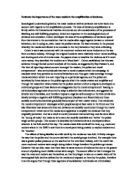Evaluate the importance of the mass media in the amplification of deviance.
Sociological understanding behind the mass media as well as deviance has to be taken into account with regards to the amplification process. The idea of deviancy amplification is firmly within the Interactionist tradition and comes out of a consideration of the processes of labelling and self-fulfilling prophecy, which are important in the sociological study of deviance and education. Cohen developed the idea of the amplification of deviance spiral from his interest in the contradiction that the media often raged against deviant or criminal behaviour, but in doing so, often made the problem worse. He was interested in the process whereby the media contributed to an increase in the very behaviour they were criticising.
Cohen’s work was concerned with the mods and rockers and some incidents on the sea front one bank holiday. Although the original incidents were relatively minor- some scuffling and shoving and a lot of drunkenness- the papers chose to headline the violence as if it much more worse; they described the incident as a ‘blood bath’. Cohen established that this was achieved through formal content analysis of the media, as suggested by Ray Pawson’s, and this kind of reporting created concern amongst the readers, the police and moral entrepreneurs’- who are individuals that start a moral crusades which is a campaign to eradicate what they perceive as immoral behaviours and they gain mass coverage through media saturation which is a over reporting on a particular agenda, and the police are sensitised by these issues on the public agenda which the media creates and amplifies and through the masculine views created by the polices canteen culture a stigma is developed on individual groups and these factors are exaggerated by the moral entrepreneurs’ leading to institutionalised agencies of control to adapt a selective law enforcement, as suggested by Streeter and Chambliss, and therefore impose a negative self-concept on the folk-devils who slowly develop a negative self-fulfilling prophecy (Jacobson and Rosenthal) and these socially constructed identities gradually become part of their master status. This reinforces the moral entrepreneurs’ ideologies which people accept at face value in the future and this also illustrates how issues of crime and deviance are socially constructed through the moral entrepreneurs’ initial use of the media as an apparatus to amplify the deviance that they originally perceived. And as a result in society demands that something must be done about the ‘young of today’ are made so as to seem act socially desirable and ‘active’ the police target certain groups. This concern is described by Interactionist as a moral panic about whoever is the folk devil of the day. The media create folk devils all the time, e.g. mods and rockers where in the 1960’s now there is a moral panic being created on asylum seekers and the ‘hoodies’.








